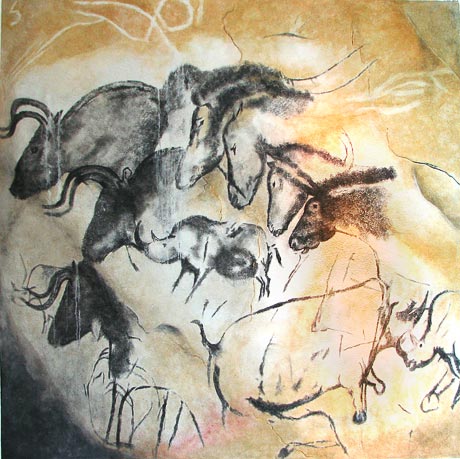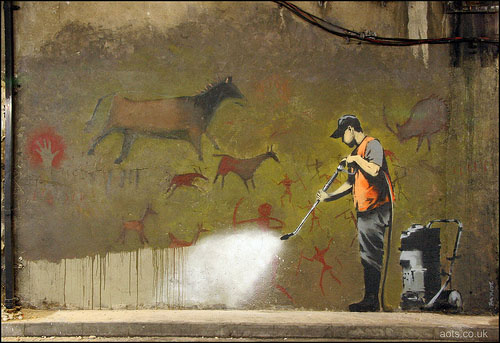
I have always lived life close to animals. When I was two years old, my dad's boss went bankrupt, and perhaps to unload some of his burden of guilt, but more likely to unload some extra expenses, he unloaded two worthless ponies on my dad. Not a great moment for the family finances, but a dream come true for my little girl self, and an extraordinary golden ticket to independence. Mom and Dad sent my first dog, Pepper, 'to live on a farm,' because he kept jumping the fence of our suburban back yard and making every manner of trouble for the neighbors, but he was followed rapidly by Fritzl, Josh, Wallis, Molly, Titus and now Zillie.


Some of the canines befriended the family felines, some warred with them. Now I also have fish, a backyard turtle-- except I think he escaped last week-- and two birds.


So, it should come as no surprise that I also fill my studio with a menagerie of ceramic animals. And it may not surprise you that prehistoric artists made most of their work about animals, either. It did not surprise me-- just as it doesn't surprise me that people from all eras of the past who lived their lives far, far closer animals of all kinds than I live envisioned that endowed animals with special powers, connected them to particular gods, and embraced them as symbols of particular ideas and attitudes. As John Berger writes, before the 19th century, "animals constituted the first circle of what surrounded man. Perhaps that already suggests too great a distance. They were with man at the centre of his world." (from "Why Look at Animals," from About Looking, 1977).
In prehistoric times, artists, most of them young men, descended into dark and dangerous places to leave their marks on wall.

A young man from 30,000 years ago waves to us from a spray painted image from Chauvet Cave in modern-day France. He would have let the cave with a red hand.

animals stampede, freeze, attack in a mural painted by generations of paleolithic wall painters
The overwhelming majority of these young men painted animals-- bulls, cave lions, cave bears, deer, horses leading the pack. The fact that young men made most of these images, that they painted their marks over one another's work for thousands of years running, that they used spraypaint, that they painted in dark and at least moderately dangerous conditions, that they painted images without the rigid outline of rectangular picture planes that most formally-trained artists rely on.... all these features tie cave painters from 30-10,000 years ago to street artists of the postmodern era.


Swoon, untitled, wheatpaste, 14th St. NYC, 2005
To make the point, I show a picture by Swoon, who breaks a few of the stereotypes of street art. For one thing, she's a she-- but the fact that that is worth remarking on shows how exceptional it is. For another, she trained as a painter in an art school before adopting the practices of street artists. Now she plays in (at least) two worlds-- in the gallery and on the streets. 
Swoon, untitled, detail. wheatpaste, 14th St. NYC, 2005
like paleolithic European cave paintings, Swoon offers a simple first layer for quick interpretation-- a graceful but rough around the edges female figure gazes at us directly over a wrought iron fence. Closer inspection reveals far more: the asian script of the newspaper she paints and pastes up, the tie to European woodblock printing most recognizable from propaganda posters, birds fleeing the scene darkly, a city of types inhabits the folds of her dress.
Perhaps the most famous street artist working today, Banksy, made the tie between his work and cave painting explicit beyond doubt. In his work, which one blogsite captioned: "The law of savages: Destroy what you don't understand," Banksy showed a public worker cleaning up 20,000 year old graffiti.

Perhaps the most famous street artist working today, Banksy, made the tie between his work and cave painting explicit beyond doubt. In his work, which one blogsite captioned: "The law of savages: Destroy what you don't understand," Banksy showed a public worker cleaning up 20,000 year old graffiti.

Banksy Cave Painting Graffiti removal, Cans Festival
This post may just add up to another instance of me standing on my soapbox saying: "Think, learn, ask questions, but never think you know the answers. Here's a question: Why have humans painted on cave walls for 30,000 years? Why do humans represent animals? Why does looking at, thinking about, and representing animals teach us about humans?


No comments:
Post a Comment